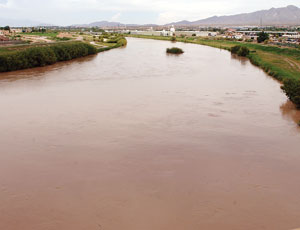If the House stimulus bill passes, water resource and navigation would get $5.4 billion distributed by four federal agencies: the Army Corps of Engineers, the International Boundary and Water Commission, the Natural Resources Conservation Service of the Dept. of Agriculture and the Coast Guard.

The Corps has the largest cut by far, $4.5 billion, although some expected three times more. “The number working through Congress about three weeks ago [for water resources] was $13 billion or $14 billion,” says Rob Vining, vice president of HNTB Federal Services Corp., Arlington, Va., who was civilian chief of the Corps’ program management division for civil works from 2001 to 2005. “It is surprising so little of the stimulus package is addressing critical water infrastructure.”
D. Wayne Klotz, president of the American Society of Civil Engineers, notes that while the stimulus would provide welcome funding for infrastructure, it falls far short of actual need. The proposed investment “of only $4.5 billion is less than what is needed for the Corps to reach its goals over the next two years,” he notes. “To protect public safety and meet the nation’s economic needs, ASCE urges an additional $7 billion be allocated to the Corps,” he says.
Contacts with the four agencies indicate none submitted priority lists. In the case of IBWC, its spokeswoman was unaware it was tagged for $224 million for flood control and levee repairs on the lower 200 miles of the Rio Grande River until called by ENR. “That’s big,” said Sally Spener. “This is a very large amount of money compared to what we’ve seen for levee work.”
IBWC’s typical construction budget runs $3.5 million to $4 million, except in 2008, which saw an $88-million bump for a wastewater treatment plant near San Diego, Spener says. But the groundwork for the big levee reconstruction project already has been laid. The environmental impact statements are complete, “so we are ready to move forward to design and construction” of the $224-million levee project, Spener says.
Eugene Pawlik, spokesman for the Corps’ civil and emergency operations ,says, “There is very little we can say. It’s proposed legislation. As an agency, we don’t want to be seen as trying to influence legislation or lobbying for money.”

Funds for watersheds, flood protection, navigation and hydropower via four federal agencies.
Of the Corps’ $4.5 billion, the bill allocates $2 billion for construction against a $61-billion backlog of authorized but unfunded work and $250 million for the Mississippi River and Tributaries program. Against a $1-billion operations and maintenance backlog that grows by $100 million a year due to aging infrastructure, it allocates $2.225 billion. The Corps estimates $2 billion could be expended on dam safety alone. The bill now sets aside $25 million for regulatory purposes.
There are limitations. It would let the Corps select the projects, provided it gives preference to ones “that are labor-intensive.” The funds also are for work that was previously funded and that can be finished within two years. Projects also may not cost-share with the Inland Waterways Trust Fund.
A freer hand is given the NRCS, which would get $400 million for watershed infrastructure, including $175 million for flood protection, such as repairing dams, and another $175 million for water-quality projects, including buying and restoring conservation easements in river flood zones. Douglas McKalip, legislative director, says NRCS was not asked for a list of priority projects either, although it “answered a multitude of questions” in recent weeks. “They were very keenly interested in making sure they didn’t fund any project that had been earmarked,” he says.
The smallest appropriation goes to the Coast Guard: $150 million for ready-to-go investments to repair or remove 12 railway bridges deemed hazardous to marine navigation.





Post a comment to this article
Report Abusive Comment